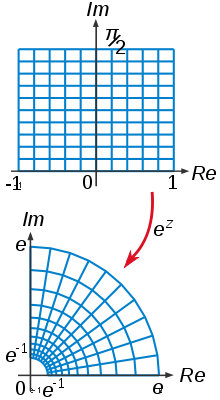Archaeocryptography
Archaeocryptography (from Greek ἀρχαῖος, arkhaios, "ancient" and κρυπτός (kruptós), "hidden, secret"; and γράφειν (graphein), "to write") is the study of decoding a monument or structure by determining the underlying mathematical order beneath the proportions, size, and placement to find any re-occurring or unusual data in respect to that which is being studied,[1] or within another monument or structure.

Archaeocryptography is not a recognized branch of archaeology or of any other academic discipline. It is an example of pseudoscience or pseudoarchaeology that employs contrived calculations involving many free parameters to achieve an impressive-looking result.[2]
Description
The word archaeocryptography is derived from archaeology, which is the study of human activity in the past, and cryptography, which is the study of techniques for secure communication in the presence of third parties.
Methods

Archaeocryptologists try to find underlying correlations in respect that which is being studied or decoded.[3] Some factors taken into consideration while deciphering an object, structure or megalithic monument can include the features such as faces, stairs, sides, and terraces. The geolocation or mathematical operations are performed on latitude and longitude coordinates[1] as well as astronomical alignments, such as are found with archaeoastronomy. The incorporation of grids,[4] the use of numerical ordering, mathematical constants, Biblical gematria, and any other re-occurring number that might stand out from the decoding process are determining factors.
Archaeocryptologists then can use different mathematical formulas to find correlations within that which is being studied or between other monuments or structures that share any underlying factors. Popular examples are the Orion correlation theory [5] between the Giza pyramid complex and the three middle stars of the constellation Orion, and also theories[6] about the region of Cydonia on Mars.
History
The coining of the word archaeocryptography is often attributed to Carl P. Munck,[2][7] who after retiring from the United States military in the late 1970s began studying cartographic material, among other topics, trying to search for better answers as to why certain megalithic monument exist. This led him to a formula he believes architects used to place and design various megalithic monuments.[8] Munck's theory claims that calculations using selected numbers or dimensions found in megalithic monuments or Egyptian pyramids yield the latitude or longitude of the site.[2] However, in Munck's findings, the prime meridian does not run through Greenwich, but through the Great Pyramid in Giza. His theory is known simply as "The Code" and asserts that an ancient numerological system known as gematria is used in the manipulation of numbers to other key locations, mathematical components and positions of sights in the geometry of their construction.
The theory later become popularized and among other practitioners and researchers in pseudo-scientific fields, such as Michael Lawrence Morton, Richard C. Hoagland, Bruce Cathie, and Hugh Harleston Jr. They adapted archaeocryptography to their own studies, developing different theories [9][10] and books [6][11][12] based on the topic.
In literary studies
The marginal, or even fictional, status of archaeocryptography was suggested in Zachary Mason's novel The Lost Books of the Odyssey, which purports to be a collection of lost works which the author describes as being as old as the Odyssey and which he claims to have decoded from a manuscript he had uncovered. In the author's biography at the conclusion of the book he describes himself as "the John Shade Professor of Archaeocryptography and Paleomathematics at Magdalen College, Oxford". The "lost books" were actually written by Mason and, as reviewers have noted, Mason is a novelist and computer scientist who lives in California, John Shade is a fictional poet in Vladimir Nabokov's Pale Fire, and no such professorship exists.[13][14]
See also
References
- Munck, Carl. "The Spirit of Ma'at". Spirit of Maat. Retrieved 2 November 2012.
- Schmeh, Klaus (2012), "The Pathology of Cryptology—A Current Survey", Cryptologia, London: Taylor and Francis Group, 36: 14–45, doi:10.1080/01611194.2011.632803,
Arguments against archeocryptography are…: There are many numbers involved, which can be arranged in many different formulas and matched against many different values. Munck’s claims, therefore, would only be valid with a statistical foundation that proves that his findings are more than merely coincidence. However, Munck has never provided a proof like this.
- Laura Lee. "Archaeocryptography, Carl Munck". Archived from the original on 2013-02-08. Retrieved 2012-09-26.
- Wilcock, David (2011). Chapter 11: Global Grid 2. New York: Penguin Group.
- Bruce, Alexandra (2009). Science or Superstition (The Definitive Guide to the Doomsday Phenomenon). The Disinformation Company. pp. 46. ISBN 978-1-934708-28-6.
- Hoagland, Richard C. (1987). The Monuments of Mars: A City on the Edge of Forever. Berkeley. ISBN 978-0-9381-907-83.
- "Geomorphic Resonance, by Michael Lawrence Morton".
- Lee, L. "Archaeocryptography According to Carl Munck". Magazine, Issue 9. Atlantis Rising. Archived from the original on 20 February 2012. Retrieved 1 November 2012.
- Alexandra Bruce (2009). 2012: Science Or Superstition (The Definitive Guide to the Doomsday Phenomenon). The Disinformation Company. p. 46. ISBN 978-1-934708-28-6.
- "Corroborating Weaver's Theory Of an Alnitak Prime Meridian, by Michael Lawrence Morton".
- Harleston Jr., Hugh (1976). Mysteries of the Mexican Pyramids. Harper & Row. ISBN 978-0060143244.
- Munck, Carl P. (1976). The Code. Radio Bookstore Press. ISBN 978-1889071176.
- Taoka, Yasuko (2012), "A Liar's Yarn: Storytelling in The Lost Books of the Odyssey" (PDF), New Voices in Classical Reception Studies (7): 40–48, retrieved 8 January 2016
- Rohter, Larry (February 9, 2010). "A Calculus of Writing, Applied to a Classic". The New York Times. Retrieved 9 January 2016.
External links
- "The Code" by Carl Munck
- "The Giza Pyramids as a Stellar Representation of Orion's Belt" by Robert Bauval